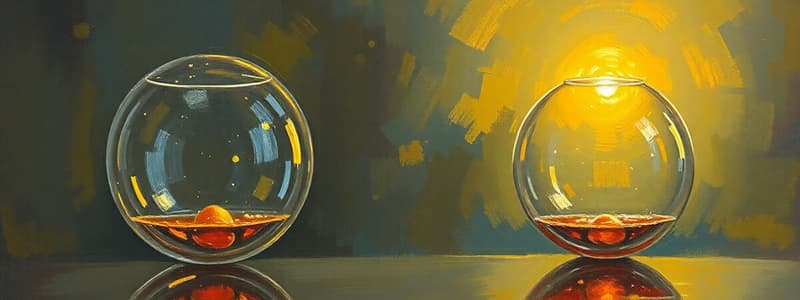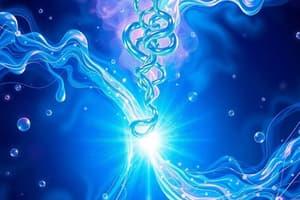Podcast
Questions and Answers
At what temperature does the equilibrium lie heavily to the right, resulting in a dark brown color?
At what temperature does the equilibrium lie heavily to the right, resulting in a dark brown color?
- 373 K (correct)
- 273 K
- 323 K
- 400 K
What does a reaction quotient Qc value of 8.0 indicate in relation to Kc?
What does a reaction quotient Qc value of 8.0 indicate in relation to Kc?
- The reaction will move to the right to establish equilibrium. (correct)
- There is no change expected in the reaction.
- The reaction will move to the left to establish equilibrium.
- The reaction is already at equilibrium.
What color change occurs when starting with only N2O4 at 323 K?
What color change occurs when starting with only N2O4 at 323 K?
- The color fluctuates between shades
- The color becomes darker (correct)
- The color remains colorless
- The color becomes lighter
What is the equilibrium constant Kc for the reaction at 25°C given the concentrations of gases?
What is the equilibrium constant Kc for the reaction at 25°C given the concentrations of gases?
Which of the following statements about chemical equilibrium is true?
Which of the following statements about chemical equilibrium is true?
What does a Kc value significantly less than 1 indicate about the reaction's equilibrium position?
What does a Kc value significantly less than 1 indicate about the reaction's equilibrium position?
When calculating Kc, which substances are included in the expression?
When calculating Kc, which substances are included in the expression?
If the value of Kc is 57.0, what does it imply about the reaction at 700 K?
If the value of Kc is 57.0, what does it imply about the reaction at 700 K?
If Kc is represented as [C]c [D]d / [A]a [B]b, what does the subscript 'c' refer to?
If Kc is represented as [C]c [D]d / [A]a [B]b, what does the subscript 'c' refer to?
Which of the following is NOT a characteristic of dynamic equilibrium?
Which of the following is NOT a characteristic of dynamic equilibrium?
What is the preferred method for defining the equilibrium constant Kp in a gas reaction?
What is the preferred method for defining the equilibrium constant Kp in a gas reaction?
What does the term Δn represent in the equation related to Kp and Kc?
What does the term Δn represent in the equation related to Kp and Kc?
Which condition will affect the value of Kc?
Which condition will affect the value of Kc?
How are Kc and Kp related?
How are Kc and Kp related?
What can be concluded about the equilibrium when only starting with NO2 at 323 K?
What can be concluded about the equilibrium when only starting with NO2 at 323 K?
What is the primary role of equilibrium constants Kc and Kp?
What is the primary role of equilibrium constants Kc and Kp?
What is the relationship between Kp and Kc for the equilibrium reaction involving gases?
What is the relationship between Kp and Kc for the equilibrium reaction involving gases?
In the equilibrium expression for the reaction CaCO3(s) ⇌ CaO(s) + CO2(g), which species is included in Kc?
In the equilibrium expression for the reaction CaCO3(s) ⇌ CaO(s) + CO2(g), which species is included in Kc?
What does a large value of Kc (e.g., $2.4 imes 10^{47}$) indicate about a reaction's equilibrium position?
What does a large value of Kc (e.g., $2.4 imes 10^{47}$) indicate about a reaction's equilibrium position?
What should be excluded when writing the equilibrium expression?
What should be excluded when writing the equilibrium expression?
How do you express the equilibrium constant Kc for the reaction 2 H2(g) + O2(g) ⇌ 2 H2O(g)?
How do you express the equilibrium constant Kc for the reaction 2 H2(g) + O2(g) ⇌ 2 H2O(g)?
Which of the following describes heterogeneous equilibria?
Which of the following describes heterogeneous equilibria?
What does a small Kc value (e.g., $4.2 imes 10^{-48}$) imply about a chemical equilibrium?
What does a small Kc value (e.g., $4.2 imes 10^{-48}$) imply about a chemical equilibrium?
What does the concentration formula indicate for a pure liquid in a chemical reaction?
What does the concentration formula indicate for a pure liquid in a chemical reaction?
What is the condition necessary for a chemical system to achieve dynamic equilibrium?
What is the condition necessary for a chemical system to achieve dynamic equilibrium?
Which statement accurately describes dynamic equilibrium?
Which statement accurately describes dynamic equilibrium?
How does the concept of chemical equilibrium answer 'how far' does a reaction proceed?
How does the concept of chemical equilibrium answer 'how far' does a reaction proceed?
What occurs when a reaction reaches an equilibrium state?
What occurs when a reaction reaches an equilibrium state?
In the example of N2O4 and NO2, what does the observation of color indicate at equilibrium?
In the example of N2O4 and NO2, what does the observation of color indicate at equilibrium?
What happens to the equilibrium position when a reversible reaction starts with excess reactants?
What happens to the equilibrium position when a reversible reaction starts with excess reactants?
What substance color indicates N2O4 in an equilibrium reaction with NO2?
What substance color indicates N2O4 in an equilibrium reaction with NO2?
What are the implications of a chemical reaction not going to completion?
What are the implications of a chemical reaction not going to completion?
Flashcards
Dynamic Equilibrium
Dynamic Equilibrium
A state where the rates of the forward and reverse reactions are equal, and the concentrations of reactants and products remain constant.
Equilibrium Constant (Kc)
Equilibrium Constant (Kc)
A measure of how far a reaction proceeds to completion. It's the ratio of products to reactants at equilibrium.
Chemical Equilibrium
Chemical Equilibrium
A reversible reaction where the forward and reverse reactions occur at equal rates, resulting in a constant concentration of reactants and products
Reversible Reactions
Reversible Reactions
Signup and view all the flashcards
Equilibrium Point
Equilibrium Point
Signup and view all the flashcards
Equilibrium Mixture
Equilibrium Mixture
Signup and view all the flashcards
Position of Equilibrium
Position of Equilibrium
Signup and view all the flashcards
Le Chatelier's Principle
Le Chatelier's Principle
Signup and view all the flashcards
Change in moles of gas (Δn)
Change in moles of gas (Δn)
Signup and view all the flashcards
Equilibrium lying to the left
Equilibrium lying to the left
Signup and view all the flashcards
Equilibrium lying to the right
Equilibrium lying to the right
Signup and view all the flashcards
Color change during equilibrium
Color change during equilibrium
Signup and view all the flashcards
Equilibrium lies heavily to the left
Equilibrium lies heavily to the left
Signup and view all the flashcards
Reaction quotient (Qc)
Reaction quotient (Qc)
Signup and view all the flashcards
Qc < Kc
Qc < Kc
Signup and view all the flashcards
Qc > Kc
Qc > Kc
Signup and view all the flashcards
Qc = Kc
Qc = Kc
Signup and view all the flashcards
Kp and Kc Relationship
Kp and Kc Relationship
Signup and view all the flashcards
Homogeneous Equilibrium
Homogeneous Equilibrium
Signup and view all the flashcards
Heterogeneous Equilibrium
Heterogeneous Equilibrium
Signup and view all the flashcards
Pure Liquid/Solid Concentration
Pure Liquid/Solid Concentration
Signup and view all the flashcards
Kc Expression for Heterogeneous Equilibrium
Kc Expression for Heterogeneous Equilibrium
Signup and view all the flashcards
Large Kc Value
Large Kc Value
Signup and view all the flashcards
Small Kc Value
Small Kc Value
Signup and view all the flashcards
Equilibrium Position
Equilibrium Position
Signup and view all the flashcards
Study Notes
Chemical Equilibrium 1
- Chemical equilibrium is the state where the concentrations of reactants and products remain constant.
- In this state, the forward and reverse reactions occur at equal rates, meaning there is no net change in the amounts of reactants or products.
- Equilibrium is only applicable to reversible reactions, meaning a reaction could go in either direction.
- Kinetics (how fast) is different than equilibrium (how far), as kinetics questions how quickly a reaction occurs, whereas equilibrium focuses on the final position of the reaction.
Dynamic Equilibrium
- Dynamic equilibrium in a reaction occurs when the rates of the forward reactions and the reverse reaction are equal.
- At this point, the reaction appears to stop but the forward and reverse reactions continue.
- The forward reaction creates products; the reverse reaction recreates reactants.
- The rates of the forward and reverse reactions are equal at equilibrium, but the amounts of reactants and products do not have to be equal.
Equilibrium Expressions
- Equilibrium constants (K) describe the relationship between the concentrations of reactants and products at equilibrium.
- For a general reaction aA + bB ⇌ cC + dD, the equilibrium constant Kc is defined as: Kc = [C]c[D]d / [A]a[B]b
- The subscript 'c' denotes the use of concentrations (molarities).
- This expression is only applicable when the reactants and products are liquid, or aqueous.
Equilibrium Constant Kp
- When dealing with gases, it's easier to measure partial pressures, hence a different expression for the equilibrium constant, Kp.
- Kp = (PC)c(PD)d / (PA)a(PB)b
- Equilibrium constant Kp is used when the reactants and products are gases.
Relating Kc and Kp
- Using the ideal gas law, the relationship between Kc and Kp is given by the following expression:
- Kp = Kc(RT)Δn , where Δn is the change in the number of moles of gas between products and reactants.
Heterogeneous Equilibria
- In homogeneous equilibria, all reactants and products are in the same phase.
- In heterogeneous equilibria, reactants and products are in different phases.
- Pure liquids and solids are omitted from equilibrium expressions.
- For example, in the reaction CaCO3(s)⇌CaO(s) +CO2(g), only the concentration of CO2 is included in the equilibrium expression.
Using the Equilibrium Expression
- The reaction quotient (Q) is used to predict the direction of a reaction when it is not at equilibrium.
- If Q < Kc, the reaction will proceed to the right (towards products).
- If Q > Kc, the reaction will proceed to the left (towards reactants).
- If Q = Kc, the reaction is at equilibrium.
Studying That Suits You
Use AI to generate personalized quizzes and flashcards to suit your learning preferences.




